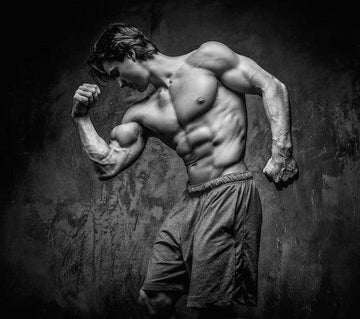

Gain Mass with this High Volume Muscle Pump Program
Table of Contents
Pumping Muscles for Monster Growth: A unique perspective on the benefits of pumping up
By Stephane Cazeault, The Poliquin Group
Reprinted from Muscle Media Magazine
In the early days of muscle building when Venice Beach was the mecca, it was rumored that many bodybuilders would visit the gym multiple times a day to get a pump. This was not meant as a training method to force the body to greater levels of growth but merely to look their biggest, longer. Vanity aside, there are some benefits of getting a pump for pump’s sake. The late Larry Scott was a strong believer in using the pump to monitor the quality of a workout. Scott won the first Mr. Olympia title in 1965 and followed that up with another Sandow trophy in 1966. At a height of just 5 feet 8 inches, at his peak condition Scott weighed 205 pounds and his arms reportedly measured over 20 inches. Those arms were considered the best of his era, especially his biceps, which possessed long muscle bellies that presented a fullness and shape that separated Scott from his competitors. In fact, Scott used to joke that he would have to tuck his thumbs into his belt loops to rest his traps because they would get exhausted from supporting the weight of his arms.Scott believed that when bodybuilders started losing their pump it was a sign that an exercise was no longer effective and they should move on to another exercise. The most practical way to determine your pump is to use a tape measure after each set – a Gullick tape is best for this purpose, as the tape will maintain the same degree of tension to ensure your measurements are accurate. Scott’s approach to the pump is the same line of reasoning used with the critical drop-off point. This is the training concept that when you reach a point at which you cannot produce a significant level of muscle tension to elicit gains, you should terminate the set. Generally speaking, this point represents a 5-7 percent drop in performance. For example, if your bench press peaks out on 220 pounds for 6 reps and on a subsequent set you only manage 3 reps, you’re done.

What is not true is the idea that you must have a pump to create gains in strength. Olympic lifting and powerlifting can certainly make an athlete stronger, but such training is not associated with any significant pumping of the muscles. As for muscle size, a certain level of muscle tension is necessary to achieve a strength training effect, and you cannot obtain this tension threshold with light weights. In other words, using appropriate training methods to build muscle size may result in a pump, but it’s the muscle tension that causes the growth response, not the pump.
As for the value of the pump, there are assorted theories. One theory is that the pump stretches the fascial tissue that surrounds the muscle, and as such allows for more muscle size. Another idea is that the pump provides feedback about the effectiveness of an exercise in targeting a muscle group. For example, if you feel bench presses only in your triceps rather than in your pecs, this suggests that arm strength is limiting the effectiveness of this exercise and you need to adjust your program.

Beyond these possible considerations, be aware that there is a specific hormonal response from performing high-rep, “back-off sets.” Here’s how it works: The pump develops high levels of lactate, which in turn increases the production of growth hormone – growth hormone is associated with fat loss and muscle gain. To take advantage of this process begin a superset with an exercise designed to produce an optimal amount of muscle tension to stimulate growth. Immediately follow this with an especially high-rep set designed to produce a high level of growth hormone, a set that will produce a serious pump. As a general guideline, the amount of weight to use on a back-off set will be about 55 percent of your best effort for a single (i.e., one-rep max).
The following is an example of such a workout for the chest. It starts with a superset using a back-off set and is followed by a post-exhaustion superset (that starts with a compound exercise followed by an isolation exercise that works one of the same muscle groups).
- Flat Barbell Bench Press, 4 x 8-10, rest 120 seconds
- Flat Barbell Bench Press, 1 x 25, rest 120 seconds
C1. Incline Dumbbell Press, 4 x 10-12, rest 10 seconds
C2. Incline Dumbbell Flye, 4 x 12-15, rest 120 seconds
The pump is a vital part of the bodybuilding experience, and there may other benefits associated with this training effect besides looking bigger. Until scientific studies provide absolute answers, here’s to enjoying improved muscle growth with back-off sets.
MUSCLE MEDIA MAGAZINE FOR MEN
The premier source of training, nutrition, supplements, fat loss and health for men.

















